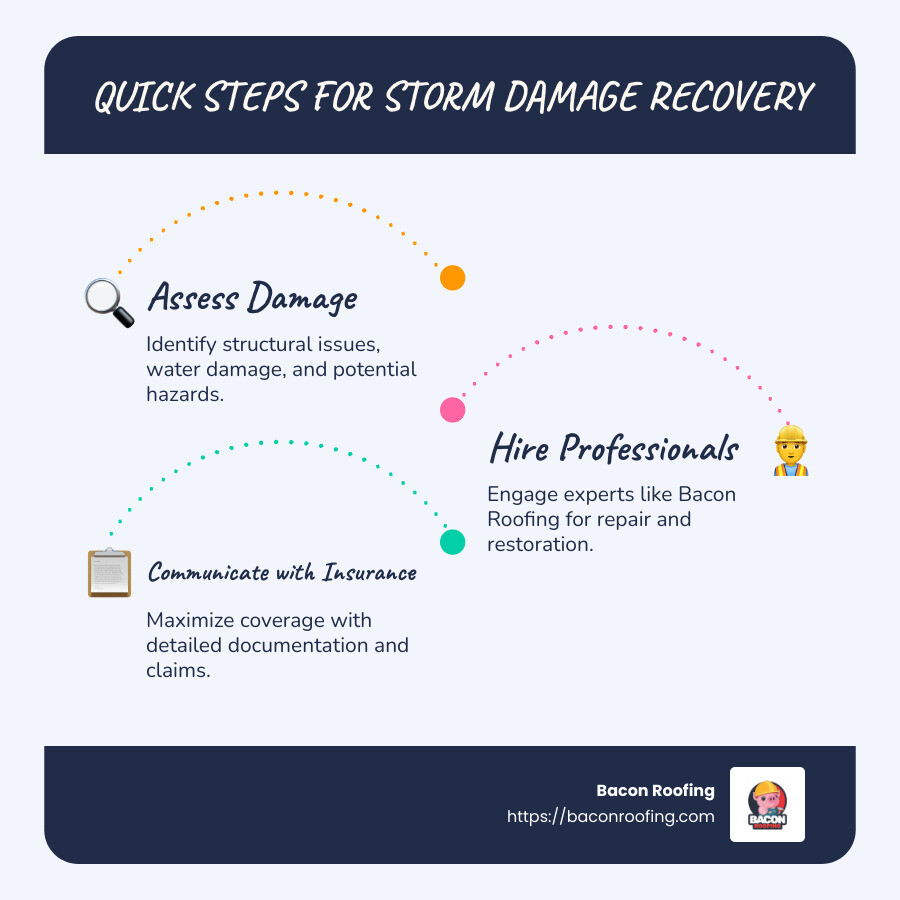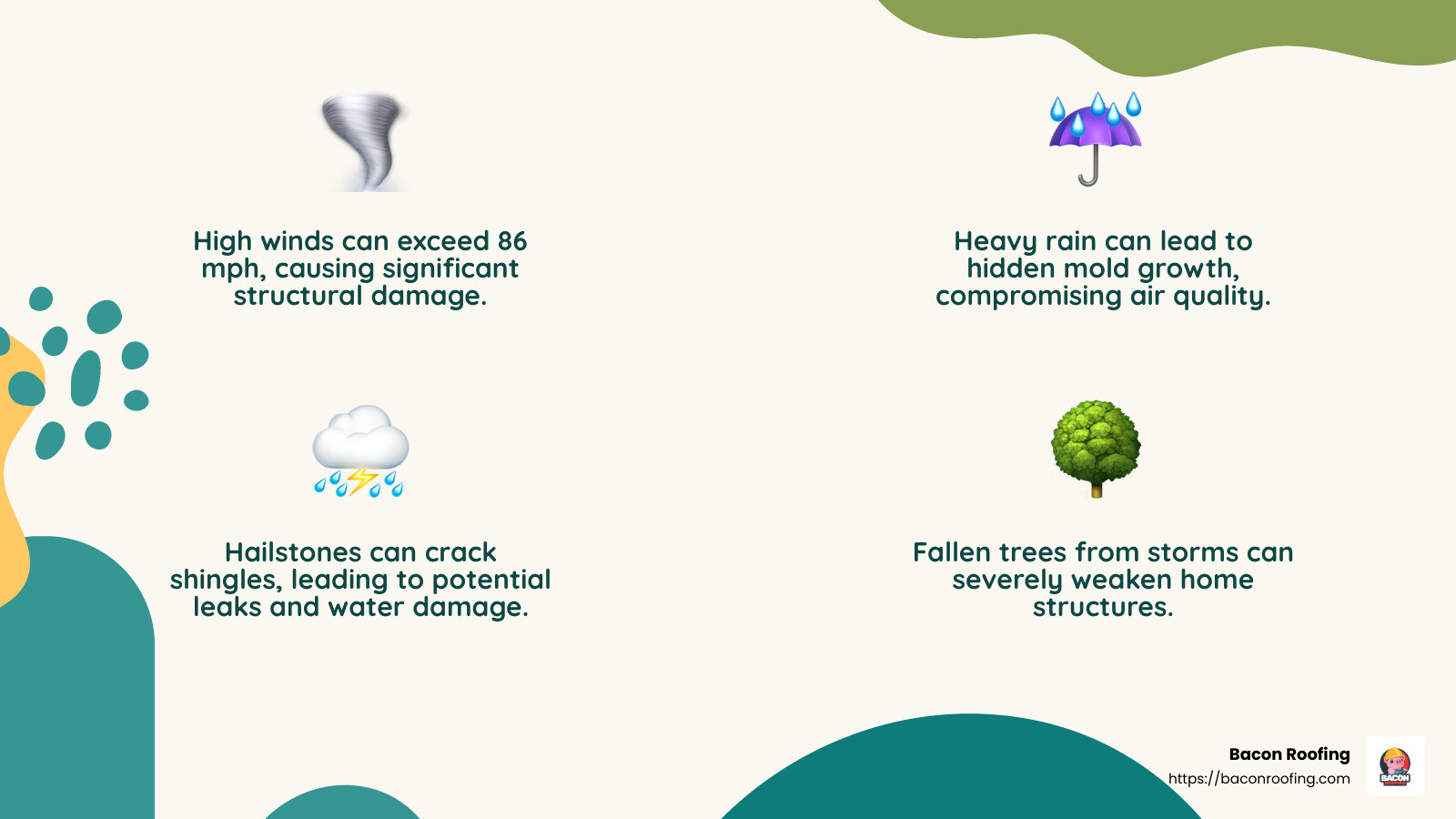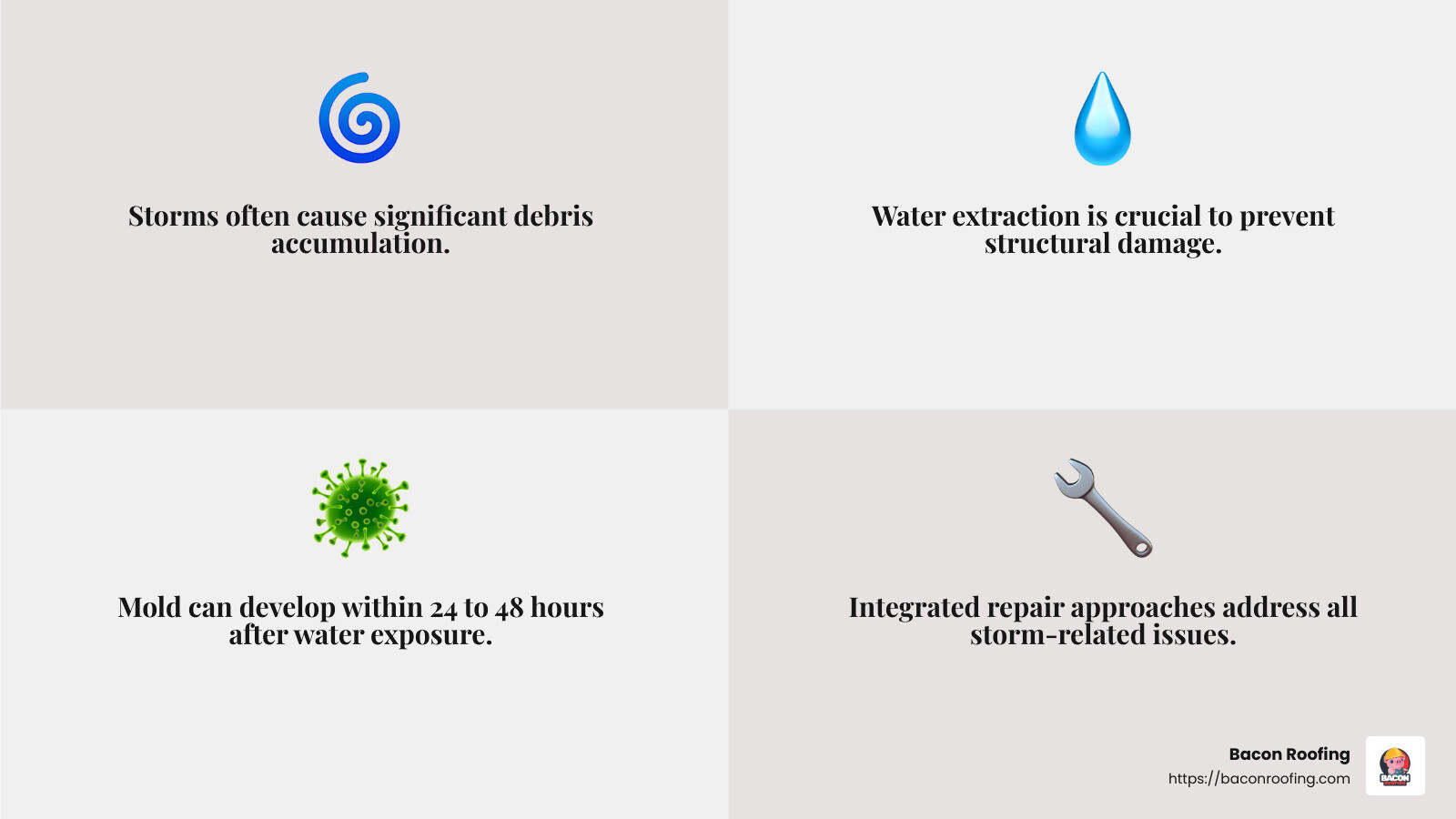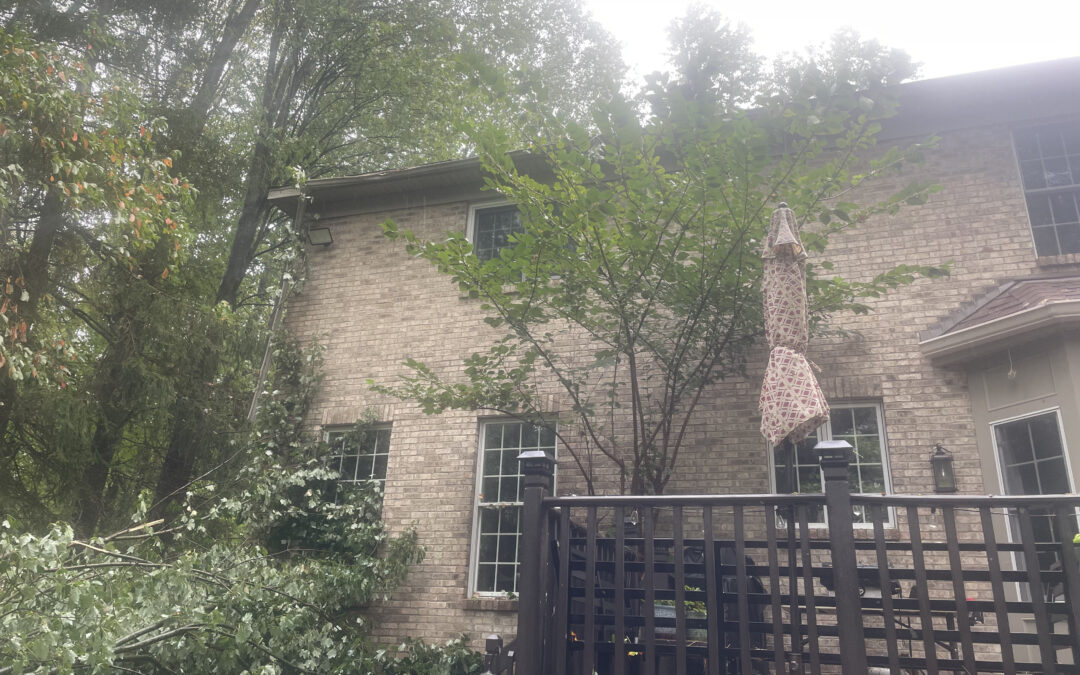Storm damage repair services are a lifeline for homeowners facing the aftermath of a storm. Swift and effective repair and restoration can bring peace of mind during these challenging times. Here’s what you need to know:
- Assess Damage: Identify structural issues, water damage, and potential hazards.
- Contact Professionals: Engage experts like Bacon Roofing for thorough repair and restoration.
- Communicate with Insurance: Maximize coverage with detailed documentation and claims.
In the face of unpredictable weather, the path from devastation to recovery can seem daunting. However, with the right storm damage repair services, you can restore your home and regain your sense of security. Storms bring chaos, but professional evaluation and efficient restoration can transform turmoil into tranquility. By partnering with experienced restoration experts, you can ensure your property is revived to its former glory.
As John Bacon, founder of Bacon Roofing, I have spent over 25 years helping homeowners steer storm damage repair services. My team and I are committed to delivering top-notch craftsmanship and customer care in the DFW area. Join us as we dig deeper into the steps and services essential for a successful recovery.

Understanding Storm Damage
When a storm hits, the damage it leaves behind can be overwhelming. Understanding the different types of storm damage is crucial for effective recovery and restoration.
Wind Damage
Wind is a powerful force that can cause significant harm to your home. High winds, often exceeding 86 mph during tornadoes, can rip shingles from roofs, topple trees, and even lift entire structures like mobile homes off their foundations. This type of damage can expose your home to further issues, such as water intrusion and structural instability.
Hail Damage
Hailstorms can be just as destructive. Hailstones, sometimes as large as golf balls, can crack and dent shingles, leaving them unable to protect your home from the elements. This can lead to leaks and more severe water damage if not addressed promptly.
Rain Damage
Heavy rainstorms can flood properties, causing water to seep into basements and other low-lying areas. The aftermath of rain damage is not always immediately visible, as mold and mildew can develop behind walls and under floors long after the storm has passed. This can compromise the air quality in your home and lead to health problems.
Structural Damage
Storms can weaken the structural integrity of your home. Whether it’s from fallen trees, flying debris, or high winds, structural damage poses a serious threat. It’s essential to assess your home after a storm to identify any compromised areas and address them quickly to prevent further deterioration.
Mold Infestation
Mold is a common consequence of storm damage, particularly when water is involved. Mold thrives in moist environments, and once it takes hold, it can spread rapidly, affecting both the structure and the health of the occupants. Mold remediation is a critical part of storm damage repair services, ensuring that your home is safe to live in again.

By understanding these different aspects of storm damage, homeowners can better prepare for and respond to the challenges posed by severe weather events. In the next section, we’ll explore the comprehensive storm damage repair services that can help restore your home to its pre-storm condition.
Comprehensive Storm Damage Repair Services
When a storm wreaks havoc, a swift and thorough response is key to restoring your home. Storm damage repair services ensure your property is safe, sound, and habitable again. Let’s explore the essential services that make this possible.
Debris Removal
After a storm, your property might be littered with debris—fallen trees, broken branches, and scattered roofing materials. Clearing this debris is the first step in the recovery process. Debris removal not only improves safety but also allows for a clear assessment of the underlying damage. Bacon Roofing prioritizes this step to ensure a safe and efficient restoration process.
Water Extraction
Water intrusion is a common issue following storms, especially those with heavy rain. Standing water can lead to severe structural damage and health hazards like mold. Water extraction involves removing water quickly and efficiently to prevent further damage. Using advanced equipment, professionals can extract water from basements, crawl spaces, and other affected areas, minimizing the risk of prolonged exposure.
Mold Remediation
Where there’s water, mold often follows. Mold can start growing within 24 to 48 hours after water exposure, making mold remediation a critical component of storm damage repair. This process involves identifying mold-affected areas, containing the mold to prevent spread, and removing it safely. Experts at Bacon Roofing ensure that all mold is eradicated, restoring healthy air quality to your home.
Integrated Approach
Each of these services plays a crucial role in comprehensive storm damage repair. By addressing debris, water, and mold issues, professionals can restore your home to its pre-storm condition efficiently. This integrated approach not only repairs visible damage but also tackles hidden threats that could lead to future problems.

With Bacon Roofing, your home is in experienced hands. Their commitment to quality and customer satisfaction ensures that your property is not only restored but strengthened against future storms. Next, we’ll explore the steps you should take immediately after a storm to protect your home and start the recovery process.
Steps to Take After a Storm
When a storm passes, acting quickly can make all the difference in protecting your home and reducing repair costs. Here’s a simple guide to help you steer the aftermath:
Assess Damage
First, take a careful look at your property. Check for visible damage like broken windows, missing shingles, or fallen trees. Document everything with photos and notes. This information will be crucial for insurance claims and repair estimates.
Contact Insurance
Once you have a clear picture of the damage, reach out to your insurance company. Provide them with all the documentation you’ve gathered. It’s important to be detailed in your descriptions, as insurance companies prioritize claims based on severity. STOP Restoration suggests including photos, written descriptions, and any receipts of damaged items to streamline the process.
Prevent Further Damage
While waiting for professional help, take steps to prevent additional damage. Cover broken windows with plastic or tarps and place buckets under leaks to catch water. If it’s safe, remove small debris from around your home. Safety first—never attempt repairs that could put you at risk.
Pro Tip: Many insurance policies require you to take reasonable steps to prevent further damage, so these actions can be essential for your claim.
By following these steps, you can help ensure your home is protected and your path to recovery is as smooth as possible. Next, we’ll take a closer look at the costs associated with storm damage repair and how insurance plays a role in covering these expenses.
Cost of Storm Damage Repair
When it comes to storm damage repair services, understanding the costs involved can help you plan and manage your recovery effectively. Let’s break down the key elements: average costs, insurance coverage, and repair estimates.
Average Costs
The cost of repairing storm damage can vary widely based on the extent of the damage and the specific repairs needed. On average, homeowners might spend anywhere from a few hundred to several thousand dollars on repairs. For example, minor roof repairs could cost around $500, while more extensive damage, like replacing an entire roof, might run upwards of $10,000.
Fact: According to U.S. News Real Estate, proactive measures like cleaning gutters can help reduce potential damage costs.
Insurance Coverage
Insurance can significantly ease the financial burden of storm repairs. Most standard homeowners insurance policies cover damage from wind, hail, and lightning. However, flood damage often requires a separate policy. It’s crucial to understand what your policy covers before a storm hits. This knowledge can help you avoid unexpected expenses and ensure you have the right coverage in place.
Tip: Always review your policy details with your insurance agent to confirm coverage specifics and consider adding flood insurance if you live in a high-risk area.
Repair Estimates
Getting a repair estimate is a crucial step in the recovery process. A detailed estimate will give you a clearer picture of the expected costs and help you plan your budget. When seeking estimates, it’s wise to get multiple quotes from reputable contractors. This not only helps you find a fair price but also ensures you’re working with a qualified professional.
Pro Tip: Companies like Bacon Roofing can assist with the insurance process by providing detailed damage assessments and communicating directly with insurers to expedite claims.
Understanding these aspects will help you steer the financial side of storm damage repair more confidently. Next, we’ll address some common questions about storm damage repair services to further clarify the process.
Frequently Asked Questions about Storm Damage Repair Services
Who is responsible for cleaning up after a storm?
After a storm, property owners are typically responsible for the cleanup of their own property. This includes debris removal from yards and driveways. However, it’s important to note that professional services can be hired to handle this task, ensuring safe and efficient removal. Using experts can also prevent further damage to your property during the process.
Tip: Hiring professionals for debris removal not only speeds up the process but also ensures that all potential hazards are addressed.
How does insurance work with storm damage?
Insurance plays a crucial role in managing the costs associated with storm damage. Most standard homeowners insurance policies cover damage from wind and hail, but flood damage usually requires a separate policy. When a storm hits, the first step is to assess the damage and document everything with photos and notes. This documentation is vital when filing a claim.
Claims Process:
- Contact your insurance agent immediately after the storm.
- Submit your documentation and a detailed description of the damage.
- Insurance adjusters will assess the damage and determine the payout.
Pro Tip: Companies like Bacon Roofing can assist in this process by providing detailed assessments and communicating directly with insurance companies to expedite claims.
How much does it cost to repair after a hurricane?
The cost of repairing storm damage, especially after a hurricane, can vary greatly. On average, repairs can range from $5,000 to $15,000, depending on the severity and type of damage. For instance, repairing structural damage or replacing a roof can be on the higher end of the spectrum.
Average Costs:
- Minor repairs (e.g., fixing leaks): $500 – $2,000
- Major repairs (e.g., roof replacement): $10,000 – $20,000
Repair Estimates: It’s essential to get multiple estimates from reliable contractors to understand the potential costs. This also helps in ensuring that you receive a fair price and quality service.
Fact: According to Bacon Roofing, quick action and professional assessments can prevent minor issues from escalating into major problems.
Understanding these aspects can help you steer the aftermath of a storm more effectively. Next, we’ll wrap up with a focus on Bacon Roofing’s commitment to customer satisfaction and efficient service handling.
Conclusion
At Bacon Roofing, we pride ourselves on delivering top-notch storm damage repair services with a strong focus on customer satisfaction. Our team understands that dealing with storm damage can be stressful, and we are here to make the process as smooth and efficient as possible.
Customer Satisfaction
Our commitment to customer satisfaction sets us apart. We listen to your needs and provide clear communication throughout the repair process. Our goal is to ensure that you are informed and comfortable every step of the way. We value your trust and work hard to earn it by delivering high-quality results.
Efficient Handling
Efficiency is at the heart of what we do. From the initial assessment to the final touches, we handle your home improvement projects with precision and care. Our experienced professionals use advanced techniques and high-quality materials to restore your home quickly and effectively. We understand the urgency of storm damage repairs and strive to minimize disruption to your daily life.
By choosing Bacon Roofing, you’re not just getting a service provider; you’re partnering with a team that is dedicated to restoring your peace of mind. Find more about our services and how we can help you by visiting our storm damage repair page. Let us help you turn the aftermath of a storm from chaos to calm.

